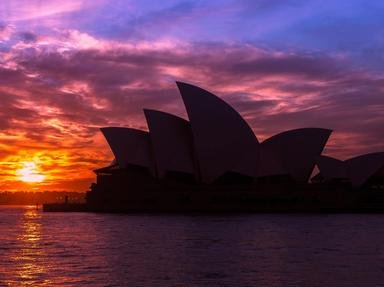Quiz Answer Key and Fun Facts
1. 1900s
...Melbourne, Federal Flag Design Competition, Dalgety, Franchise Act, Breaker Morant, Dorothea MacKeller, David Unaipon ...
Australia became a unified country on the first day of the 20th century. The move to federation had been some forty years in the making. Which, surprisingly, of the options given, was *NOT* a major driver for the six colonies to form one unified country?
2. 1910s
...Walter Burley Griffin, ANZAC Cove, Conscription, ALP Split, The Somme, Aborigines Protection Amending Act, "Six o'clock swill", Darwin Rebellion...
The ANZACs landed in Gallipoli on 25 April 1915 under British command. The campaign was a disaster for the ANZACs for a variety of reasons but most of the blame was levelled at the British generals. The retreat however, in December 1915, under Australian command was a complete success. How did the ANZACs fool the Turks into believing they had not withdrawn?
3. 1920s
...Edith Cowan, Vegemite, Miss Australia, Canberra Parliament, Shrine of Remembrance, Speedo, Pedal Radio...
The period between the end of WWI and the Great Depression in 1929 was one of optimism: household goods were affordable, the motor car was reducing the tyranny of distance, and the advances in aviation benefited Australia's development enormously. Which aviation event listed below did NOT occur in the 1920s?
4. 1930s
...Bradman, Phar Lap, Mawson, Sydney Harbour Bridge, Daisy Bates, the Utility, Milo, Thylacine, Dad and Dave, Albert Namatjira, Wirraway...
The Great Depression was the biggest "event" that occurred in the 1930s in Australia and there was an increased reliance on social welfare. For those who were out of work for a long time, which slang term described a person who received this type of social welfare?
5. 1940s
...Howard Florey, Rats of Tobruk, Darwin, mini-sub, Kokoda Trail, Daylight Savings, Hills Hoist, Light on the Hill, CSIRO...
In 1941 during World War II, one of Australia's most important speeches stated, in part, "Without any inhibitions of any kind, I make it clear that Australia looks to America, free of any pangs as to our traditional links or kinship with the United Kingdom ...". Who gave this speech?
6. 1950s
...ANZUS, Victa, Royal Visit, Petrov Afffair, Television, Melbourne Olympics, DLP split, The Wild One, Black Box, Pub with No Beer...
The 50s were a boom time for Australia: Australia embarked on an ambitious assisted immigration program to increase wealth. Infra-structure projects were commenced to provide employment primarily for immigrants as well as returned servicemen. What was the biggest infrastructure venture that Australia had ever seen that was implemented in 1950?
7. 1960s
...MacFarlane Burnett, Commonwealth Electoral Act, HMAS Voyager, Nashos, Long Tan, Decimal Currency, Jean Shrimpton, LBJ, Ronald Ryan, wine casks, Black Tuesday, Cheviot Beach, Parkes telescope, Lionel Rose...
The 1960s saw post-war babies reach adulthood and they wanted a more idealistic world as witnessed by the civil unrest seen around the globe. However despite a new generation of protest activity, there was one event in the sixties that social commentators said "significantly changed Australian society". What was this event?
8. 1970s
...Vietnam War protests, Neville Bonner, Springboks, Gough Whitlam, Opera House, Brisbane floods, Cyclone Tracy, Granville, Kakadu, Marine Park, Bionic Ear, RaceCam, Ultrasound...
It's Time. The 70s were a time of great political and social change. A left of centre Government was voted in after 23 years of Conservative rule. The new government wasted no time in implementing progressive social and political reform. The government was only in power just less than three years and implemented all of these major programs except one. Which?
9. 1980s
... Franklin River, IVF, Brisbane Games, winged keels, Ash Wednesday, enterprise bargaining, Medicare, gold coins, Anita Cobby, Bicentennial, Expo 88, Kay Cottee, Imparja, Newcastle earthquake...
If the 70s were all about social reform, then the eighties were all about economic reform. What economic policy did the Hawke-Keating Government *NOT* introduce after they were elected between 1983 and 1991?
10. 1990s
...Victor Chang, Pyramid, Mabo, Sherelle Quinn, Fightback! birthday cake, Wik, Greens, Port Arthur, Peter Doherty, gun laws, Stuart Diver, Bringing Them Home...
The 90s were marked by the effects of reform from the past two decades. The recent immigrants, from China, Vietnam, and the Middle East were changing the Australian social fabric. Many Australians thought is was time for Australia to become a republic, and time for indigenous reconciliation. In 1999 a referendum was held to determine if Australia should indeed become a republic. This was defeated despite there being popular support for same. Which one of the following reaons was *NOT* a plausible reason for Australian voters rejecting the republican model?
Source: Author
1nn1
This quiz was reviewed by FunTrivia editor
bloomsby before going online.
Any errors found in FunTrivia content are routinely corrected through our feedback system.

